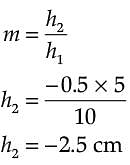Case Based Questions Test: Light- Reflection & Refraction - 1 - Class 10 MCQ
10 Questions MCQ Test - Case Based Questions Test: Light- Reflection & Refraction - 1
Following figure illustrates the ray diagram for the formation of images by a concave mirror. The position of the object is beyond the centre of curvature of the concave mirror. On the basis of given diagram, answer the questions.

If the focal length of the concave mirror is 10 cm, the image formed will be at a distance ___________.

Following figure illustrates the ray diagram for the formation of images by a concave mirror. The position of the object is beyond the centre of curvature of the concave mirror. On the basis of given diagram, answer the questions.
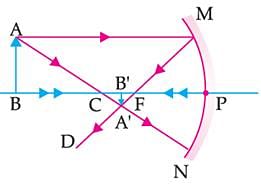
If the size of the object in the given figure is 5 cm and the magnification produced is –0.5. The size of the image is (in cm) ___________

| 1 Crore+ students have signed up on EduRev. Have you? Download the App |
Following figure illustrates the ray diagram for the formation of images by a concave mirror. The position of the object is beyond the centre of curvature of the concave mirror. On the basis of given diagram, answer the questions.
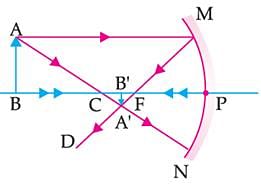
An image formed by concave mirror is virtual, when the object is placed:

Read the following passage and answer the questions.
A student wants to project the image of a candle flame on the walls of the school laboratory by using a mirror.
At what distance, in terms of focal length ‘f’ of the mirror, should he place the candle flame to get the magnified image on the wall ?
Read the following passage and answer the questions.
A student wants to project the image of a candle flame on the walls of the school laboratory by using a mirror.
If the image formed by this mirror is inverted and real, the magnification will be:
Read the following passage and answer the questions.
A student wants to project the image of a candle flame on a screen 30 cm in front of a mirror by keeping the flame at a distance of 15 cm from its pole.
Suggest the type of mirror he should use:
Read the following passage and answer the questions.
A student wants to project the image of a candle flame on a screen 30 cm in front of a mirror by keeping the flame at a distance of 15 cm from its pole.
When object distance is less than focal length the image is _______ and when object distance is more than focal length the image is ______.
Read the following passage and answer the questions.
A student wants to project the image of a candle flame on a screen 30 cm in front of a mirror by keeping the flame at a distance of 15 cm from its pole.
The image formed in the above case is:
Read the passage and note the following observations. Answer the questions.
A student focussed the image of a candle flame on a white screen by placing the flame at various distances from a convex lens. He noted his observations as:
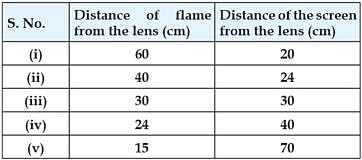
Which set of observations is incorrect and why?
Read the passage and note the following observations. Answer the questions.
A student focussed the image of a candle flame on a white screen by placing the flame at various distances from a convex lens. He noted his observations as:
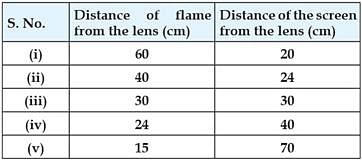
What is the change in image observed as the object is moved from infinity towards the concave lens?


